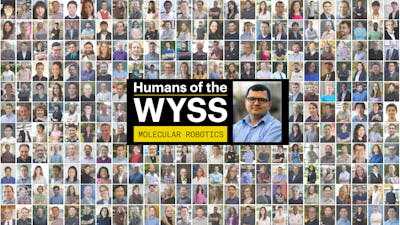
The Humans of the Wyss series features members of the Wyss community discussing how they think about their work, the influences that help shape them as scientists, and their collaborations at the Wyss Institute and beyond.
In this installment of our Molecular Robotics Edition, we talk to Postdoctoral Fellow Bhavik Nathwani, Ph.D. about his work developing DNA based metafluorophores and how he envisions his research impacting the world.
What drives you?
Fundamentally, we are trying to bring the most advanced biomedical technologies to the broadest audience. At William Shih’s lab, we are focused on utilizing DNA as a construction material to engineer ever sophisticated tools for perturbations and measurements in biology, and to explore its potential for future theranostic applications. Personally, I am really excited by the possibility of translating fundamental molecular technologies into clinically useful tools.
You’re working on DNA based metafluorophores, tell us more.
Fluorescence microscopy has provided some of the most fundamental insights in biology. Despite progress, our ability to multiplex optical information in a biological context has been limited. Synthesizing nano fluorescence reporters using DNA, we have put together a library of pulse probes. We now have the ability to, in principle, spy on thousands of molecular species simultaneously. Modest costs of DNA and rapid readout times, allow us to get excited about not only fundamental scientific discoveries that might result but also the clinical potential of this technology.
Fluorescence microscopy has provided some of the most fundamental insights in biology.
Share with us some of the challenges you’re facing.
Biological systems are rather intricate and difficult to understand. If we consider molecular species within a Eukaryotic cell to be akin to cars in a city, we don’t yet have technology to take a snapshot of where all the cars are at any given time. The challenge of following these cars as they take a ride across the cell for various physiological processes is beyond our reach. In this analogy, pulse probes act as registration plates. Our current challenge is to continue inventing technologies that allow us to take a snapshot of as many registration plates as quickly as possible. Our dream is to one day be able to generate a high-fidelity video of all molecular traffic within a given cell.
So, how do you envision pulse probes impacting the world?
Working at a place like Wyss, one is surrounded by open questions in biology that people are beginning to tackle in meaningful ways. Take for instance, the challenge of biomarker discovery in cancer. With improved multiplexing capability and read out rates, our hope is to dramatically improve the community’s ability for rapid and multiplexed biomarker discovery. Improved tumor classifications resulting from a larger library of biomarkers may prove to be a spring board for accelerated progress in identifying molecularly precise interventions for various cancer subtypes i.e. personalized medicine. One can imagine pulse probes playing a role in generating cellular atlases, and as a corollary greatly improve our understanding of various cell types and their functions within immune, neuronal, and other tissue types; problems that have hitherto remained intractable.
